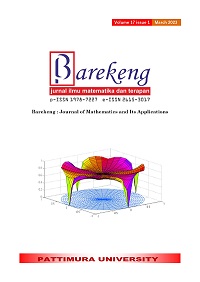STATISTICAL DOWNSCALING MODEL WITH PRINCIPAL COMPONENT REGRESSION AND LATENT ROOT REGRESSION TO FORECAST RAINFALL IN PANGKEP REGENCY
Abstract
Climate information, especially rainfall, is needed by various sectors in Indonesia, including the marine and fisheries sectors. Estimating high-resolution climate models continues to develop by involving global-scale climate variables, one of which is the global circulation model (GCM) output precipitation. Statistical downscaling (SD) relates global scale climate variables to local scales. Principal component regression (PCR) and latent root regression (LRR) techniques are statistical methods used in the SD model to overcome the high correlation between GCM data grids. PCR focuses on the variability in the predictor variables, while the LRR focuses on the variability between the response variables and predictors. This method was applied to Pangkep Regency rainfall data as a local scale response variable and GCM precipitation as a predictor variable (January 1999 to December 2020). This study aimed to obtain the number of principal component (PC) in the SD model and the forecast value of the 2020 rainfall data. In addition, the dummy variable resulting from K-means was used as a predictor variable in PCR and LRR. The result is that using the first 11-15 PC has a cumulative diversity proportion of 98%. Furthermore, by using the data for the 1999-2019 period, adding a dummy variable to the PCR can increase the accuracy of the model (the coefficient of determination is 92.27%-92.43%). However, LRR with and without dummy variables produces relatively the same model accuracy. In general, the LRR model is better at explaining the diversity of the Pangkep District rainfall data than the PCR model. The prediction of rainfall for the 2020 period at LRR with 13 PC is an accurate prediction based on the highest correlation value (0.97) and the lowest root mean square error prediction (75.17).
Downloads
References
E. Zorita and H. V. Storch, “The analog method as a simple statistical downscaling technique: comparison with more complicated methods,” J Clim, vol. 12, pp. 2474-2489, 1999.
A. H. Wigena, “Pemodelan statistical downscaling dengan regresi projection persuit untuk peramalan curah hujan bulanan (Ph.D. dissertation),” Bogor Agricultural University, Bogor, ID, Indonesia, 2006.
D. C. Montgomery and E. A. Peck, Introduction To Linear Regression Analysis, Second Edition, New York: John Willey and Sons Inc,, 1992.
Sutikno, Setiawan and H. Purnomoadi, “Statistical Downscaling Output GCM Modeling with Continuum Regression and Pre-Processing PCA Approach,” IPTEK, The Journal for Technology and Science, vol. 21, no. 3, 2010.
E. Vigneau and E. M. Qannari, “A New Algorithm for Latent Root Regression Analysis,” Computational Statistics & Data Analysis, pp. 231-242, 2002.
W. Estiningtyas and A. H. Wigena, “Teknik statistical downscaling dengan regresi komponen utama dan regresi kuadrat terkecil parsial untuk prediksi curah hujan pada kondisi el nino, la nina, dan normal,” Jurnal Meteorologi dan Geofisika, vol. 12, no. 1, pp. 65-72, 2011.
W. J. Sari, “Pemodelan Statistical Downscaling dengan Regresi Kuantil Komponen Utama Fungsional Untuk Prediksi Curah Hujan Ektrim (thesis),” Bogor Agricultural University, Bogor, ID, Indonesia, 2015.
S. Sahriman, Anisa and V. Koerniawan, “Pemodelan Statistical Downscaling dengan Peubah Dummy Berdasarkan Teknik Cluster Hierarki dan Nonhierarki untuk Pendugaan Curah Hujan,” Indonesian Journal of Statistics and Its Applications, vol. 3, no. 3, pp. 295-309, 2019.
E. Purwanto, N. Herrhyanto and M. Suherman, “Penggunaan Regresi Akar Laten Untuk Memprediksi Penjualan Mobil di Amerika Serikat Tahun 1961-1990,” Eureka Matika, vol. 2, no. 1, pp. 34-42, 2014.
D. L. Riyantini, M. Susilawati and K. Sari, “Penerapan Regresi Akar Laten Dalam Menangani Multikolinearitas Pada Model Regresi Linier Berganda,” Jurnal Matematika, vol. 3, no. 1, pp. 8-16, 2014.
D. P. Untari and M. Susanti, “Latent Root Regression Untuk Mengatasi Multikolinearitas,” Jurnal Pendidikan Matematika, vol. 12, no. 2, pp. 23-32, 2017.
R. Y. Sari, H. Oktavianto and H. W. Sulistyo, “Algoritma K-Means Dengan Metode Elbow Untuk Mengelompokkan Kabupaten/Kota Di Jawa Tengah Berdasarkan Komponen Pembentuk Indeks Pembangunan Manusia,” Jurnal Aplikasi Sistem Informasi dan Elektronika, vol. 6, no. 48, pp. 65-86, 2021.
Gujarati and N. Damodar, Basic Econometrics, New York: McGraw-Hill, 1995.
R. A. Johnson and D. W. Wichern, Applied Multivariate Statistical Analysis, Six Edition, New Jersey (NJ) : Pearson Prentice Hall, 2007.
N. R. Draper and H. Smith, Applied Regression Analysis, Second Edition, New York:: John Wiley & Sons, 1981.
Copyright (c) 2023 Sitti Sahriman, Andi Sri Yulianti

This work is licensed under a Creative Commons Attribution-ShareAlike 4.0 International License.
Authors who publish with this Journal agree to the following terms:
- Author retain copyright and grant the journal right of first publication with the work simultaneously licensed under a creative commons attribution license that allow others to share the work within an acknowledgement of the work’s authorship and initial publication of this journal.
- Authors are able to enter into separate, additional contractual arrangement for the non-exclusive distribution of the journal’s published version of the work (e.g. acknowledgement of its initial publication in this journal).
- Authors are permitted and encouraged to post their work online (e.g. in institutional repositories or on their websites) prior to and during the submission process, as it can lead to productive exchanges, as well as earlier and greater citation of published works.






1.gif)



